Current Electricity Class 12 MCQs Questions with Answers
Current Electricity Class 12 MCQ Question 1.
Consider a current carrying wire (current I) in the shape of a circle. Note that as the current progresses along the wire, the direction of ; (current density) changes in an exact manner, while the current remain unaffected. The agent that is essentially responsible for is
(A) source of emf.
(B) electric field produced by charges accumulated on the surface of wire.
(C) the charges just behind a given segment of wire which push them just the right way by repulsion.
(D) the charges ahead.
Answer:
(B) electric field produced by charges accumulated on the surface of wire.
Explanation:
As we know that current density 0)depends on
(i) conductivity [0 = 1/ ρ = 1/ R.A]
(ii) Electric field [J = σ E]
(iii) current, length and area of cross-section But in the given options only B, that is, electric field can be varied by the charges accumulated on the surface of wire.
![]()
Current Electricity MCQ Chapter 3 Question 2.
Which of the following characteristics of electrons determines the current in a conductor?
(A) Drift velocity alone
(B) Thermal velocity alone
(C) Both drift velocity and thermal velocity
(D) Neither drift nor thermal velocity.
Answer:
(A) Drift velocity alone
Explanation:
As we know that,
I = AneVd So current,
I ∝ Vd
And, current (I) also depend on n, the number of free electrons which increases on increasing temperature which makes more collision between electrons and increases resistance or decrease current.
![]()
Class 12 Physics Chapter 3 MCQ Question 3.
A metal rod of length 10 cm and a rectangular cross-section of 1 cm x \(\frac {1}{2}\) cm is connected to a battery across opposite faces. The resistance will be
(A) maximum when the battery is connected across 1 cm x \(\frac {1}{2}\) cm faces.
(B) maximum when the battery is connected across 10 cm x 1 cm faces.
(C) maximum when the battery is connected across 10 x \(\frac {1}{2}\) cm faces
(D) same irrespective of the three faces.
Answer:
(A) maximum when the battery is connected across 1 cm x \(\frac {1}{2}\) cm faces.
Explanation:
As we know that.
R = ρ \(\frac {1}{A}\)
The maximum resistance will be achieved when the value of \(\frac {1}{A}\) , is maximum, so that ‘A’ must be minimum and it is minimum when area of croea section is 1 cm x \(\frac {1}{2}\)cm.
MCQ On Current Electricity Chapter 3 Question 4.
When cell of e.m.f. E Is connected with an externa resistance R, the p4. across the cell becomes V The expression for the internal resistance of the cell is
(A) \(\frac{\mathrm{E}-\mathrm{V}}{\mathrm{V}} \mathrm{R}\)
(B) \(\frac{\mathrm{V}-\mathrm{E}}{\mathrm{V}}\)
(C) 1023
(D) \(\frac{V-E}{E}\)
Answer:
(A) \(\frac{\mathrm{E}-\mathrm{V}}{\mathrm{V}} \mathrm{R}\)
Explanation:
Current in the circuit = I – V/R
If r = internal resistance of the cell,, then
V = E – Ir
∴ r = \(\frac{E-V}{I}=\frac{E-V}{V / R}=\frac{E-V}{V}\) R
![]()
Chapter 3 Physics Class 12 MCQ Question 5.
The current density (number of free electrons per m3) in metallic conductor is of the order of –
(A) 1028
(B) 1023
(C) 1020
(D) 1015
Answer:
(A) 1028
Explanation:
The current density (number of free electrons per m3) In metallic conductor is of the order of 1028m.
Ch 3 Physics Class 12 MCQ Question 6.
Which of the following I – V characteristic represent the characteristic of a Ohmic conductor?
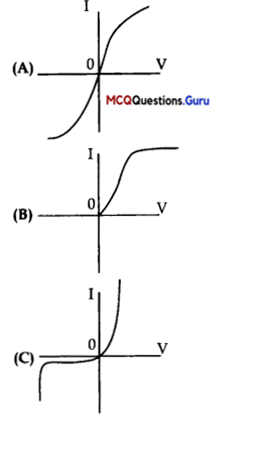
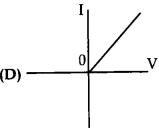
Answer:

Explanation:
Slope of 1 – V characteristic of an Ohmic conductor remains constant throughout.
![]()
MCQ Of Chapter 3 Physics Class 12 Question 7.
What is the potential difference between points A and B in the following circuit?
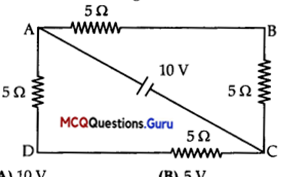
(A) 1O V
(B) 5 V
(C) 2.5 V
(D) 20 V
Answer:
(B) 5 Vs
Explnation:
Equivalent resistance of the circuit = (5 + 5)||(5 + 5) = 5 Ω
Total circuit current = 10/5 = 2A
Current In each branch is 1A So, potential dilfererice between points A and B i.e across the 5 Ω resistor is 1 x 5 = 5V
Physics Class 12 Chapter 3 MCQ Question 8.
Two batteries of emf ε1 and ε2 (ε2> ε1) and internal resistances r1 and r2respectively are connected in parallel as shown in figure:
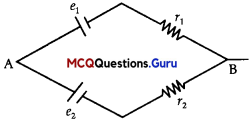
(A) The equivalent emf εeq of the two cells is between ε1 and . ε2 i.e < ε1 < ε2
(B) The equivalent emf εeq is smaller than ε1.
(C) The εeq is given by εeq = ε1 + ε2always
(D) εeq is independent of internal resistances r1 and r2
Answer:
(A) The equivalent emf εeq of the two cells is between ε1 and . ε2 i.e < ε1 < ε2
Explanation:
As we know that the equivalent emf in paraliel combination of cells is:
\(\frac{\left(\varepsilon_{1} r_{2}+\varepsilon_{2} r_{1}\right)}{\left(r_{1}+r_{2}\right)}\)
so it is dear that part ‘d and ‘d are incorrect by formula. According to this formula only option (A), is correct.
![]()
Current Electricity MCQ Class 12 Question 9.
A resistance R is to be measured using a meter bridge. Student chooses the standard resistance S to be 100 Ω. He finds the null point at l1 = 2.9 cm. He is told to attempt to improve the accuracy. Which of the following is a useful way?
(A) He should measure l1 more accurately.
(B) He should change S to 1000 Ω and repeat the experiment.
(C) He should change S to 3 Ω and repeat the experiment.
(D) He should give up hope of a more accurate measurement with a meter bridge.
Answer:
(C) He should change S to 3 Ω and repeat the experiment.
Explanation:
To calculate resistance, R
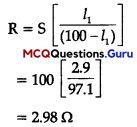
So to get balance point near to 50 cm (middle) we have to take S = 3 Ω, as here R : S = 2.9 : 971 implies that S is nearly 33 times to R. In order to make ratio R and S = 1 : 1, we must take the resistance S = 3 Ω, which verifies options (C).
![]()
Class 12 Current Electricity MCQ Chapter 3 Question 12.
Kirchhoff’s voltage law is based on the law of conservation of –
(A) charge
(B) energy
(C) mass
(D) (B) and (C)
Answer:
(B) energy
Explanation:
Kirchhoff’s current law is based on the law of conservation of energy.
MCQ Of Current Electricity Chapter 3 Question 13.
Apply Kirchhoff’s law to find the current in the part of the following circuit.
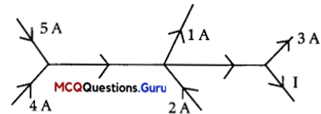
(A) 5 A
(B) 3 A
(C) 7A
(D) 1 A
Answer:
(C) 7A
Explanation:
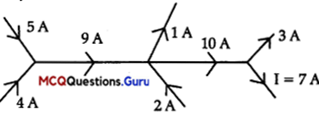
MCQ Of Current Electricity Class 12 Chapter 3 Question 14.
Wheatstone Bridge is not suitable for measurement of
(A) very high value resistances.
(B) very low value resistances.
(C) both (A) and (B).
(D) medium value resistances.
Answer:
(C) both (A) and (B).
Explanation:
Wheatstone bridge is suitable for measurement of medium value resistances because to ensure sensitivity, other resistors must be of comparable values.
![]()
MCQ On Current Electricity Class 12 Pdf Chapter 3 Question 15.
Kirchhoff’s laws are valid for …………..
(A) only passive circuits
(B) only linear circuits
(C) only non-linear circuits
(D) both (B) and (C).
Answer:
(D) both (B) and (C).
Explanation:
Kirchhoff’s laws are valid for both linear and non-linear circuits.
Class 12 Physics Ch 3 MCQ Question 16.
Two resistances are connected in two gaps of Meter Bridge. The balance is 10 cm from the zero end. A resistance of 20 Ω is connected in series with the smaller of the two. The null point shifts to 20 cm. What is the value of the bigger resistance?
(A) 89 Ω
(B) 144 Ω
(C) 100 Ω
(D) None of the above
Answer:
(B) 144 Ω
Explanation:
Case 1 :
P/Q = 10/90 = 1/9 …..(i)
Case 2: (P + 20)/Q = 20/80 = \(\frac {1}{2}\) ……(ii)
Dividing equation (i) by (ii)
P/(P + 20) = 4/9
∴ P = 16 Ω
Putting in equation (i)
Q = 144 Ω
![]()
MCQ On Current Electricity Class 12 Chapter 3 Question 17.
In a metre bridge, what is the effect on null deflection of galvanometer, when the radius of the meter bridge wire is doubled?
(A) There will be no change
(B) Null point will shift to L1 / 2 point
(C) Null point will shift to 2L1 point
(D) Null point will not be available
Answer:
(A) There will be no change
Explanation:
For a balanced Meter Bridge P/Q = L1/(100 – L1).
There is no parameter related to the radius of the wire. So, the null deflection of galvanometer does not depend on the radius of the wire. So, even if the radius of the wire is doubled, the null deflection of the galvanometer will not be changed.
Current Electricity MCQs Chapter 3 Question 18.
Consider a metre bridge whose length of wire is 2m. A resistance of 10 Q is connected across one gap of the meter bridge and an unknown resistance is connected across the other gap. When these resistances are interchanged, the balance point shifts by 50 cm. What is the value of the unknown resistance?
(A) 250 Ω
(B) 10 Ω
(C) 16.7 Ω
(D) None of the above
Answer:
(C) 16.7 Ω
Explanation:
Say, the unknown resistance X
Case 1 : 10/X = L1/(200-L1)
Or, x L1= 2000 – 10L1 …..(i)
Case 2 : X/10 = (L1 + 50)/(150 – L1)
Or, xL1 = 150 X – 10L1 – 500 ……(ii)
Comparing equation (i) and (ii)
X = 2500/150 = 16.7 Ω
![]()
MCQ Questions On Current Electricity For Class 12 Question 19.
Which error of meter bridge is removed when the known and unknown resistances are interchanged?
(A) End error
(B) Measurement error
(C) Percentage error
(D) Parallax error
Answer:
(A) End error
Explanation:
End error of metre bridge is removed when the known and unknown resistances are interchanged.
Class 12 Physics Current Electricity MCQ Chapter 3 Question 20.
In a potentiometer of 5 wires, the balance point is obtained on the 3rd wire. To shift the balance point to the 4th wire,
(A) current of the main circuit is to be decreased.
(B) current of the main circuit is to be increased.
(C) the shifting is not possible
(D) None of the above
Answer:
(A) current of the main circuit is to be decreased.
Explanation:
To shift the balance point of a potentiometer to a higher length, the potential gradient of the wire is to be decreased. This can also be achieved by decreasing the current of the main circuit. So, this is a true statement.
MCQ Class 12 Physics Chapter 3 Question 21.
Which one of the following statements is correct?
(A) Potentiometer is used to measure the current in a circuit.
(B) Potentiometer is used to measure the internal resistance of a cell.
(C) Potentiometer is used to measure the resistance of a circuit.
(D) Potentiometer is used to measure the potential difference across a resistor.
Answer:
(B) Potentiometer is used to measure the internal resistance of a cell.
Explanation:
Potentiometer is used to measure internal resistance of a cell, e.m.f. of a cell and to compare the e.m.f.’s of
![]()
Assertion And Reason Based MCQs (1 Mark each)
Directions: In the following questions, A statement of Assertion (A) is followed by a statement of Reason (R). Mark the correct choice as.
(A) Both A and R are true and R is the correct explanation of A
(B) Both A and R are true but R is NOT the correct explanation of A
(C) A is true but R is false
(D) A is false and R is true
MCQ Current Electricity Class 12 Chapter 3 Question 1.
Assertion (A): Fuse wire has high resistance and low melting point.
Reason (R): Fuse wire is for small current flow only.
Answer:
(C) A is true but R is false
Explanation:
Fuse ware should melt and disconnect the circuit from mains supply if the current increases beyond a rated value. For this reason, its resistance should be high for more heat generation and melting point should be low for fast melting. So assertion is correct. Fuse wire is not for small current flow. Fuse wire may be of various current rating depending on the type of appliance being used and the capacity of the wiring. So, the reason is false.
Class 12 Physics Chapter 3 MCQ Questions Question 2.
Assertion (A): Electric appliance with metal body has three electrical connections. But an electrical bulb has two electrical connection.
Reason (R): Three pin connection reduces chances of electrical shocks.
Answer:
(A) Both A and R are true and R is the correct explanation of A
Explanation:
The metallic body of electrical appliance is connected to the 3rd pin which is an earth pin. By any chance if the metallic body gets connected to the LIVE line, current flows to earth through this pin without giving any shock to the user. Hence assertion is true. Electric bulb does not have any metallic encloser and hence there is no requirement of earth pin. So, the reason is also true and properly explains the assertion.
![]()
Question 3.
Assertion (A): The resistance of superconductor is zero.
Reason (R): Super conductors are used for electrical power transmission.
Answer:
(B) Both A and R are true but R is NOT the correct explanation of A
Explanation:
Resistance of superconductor falls to zero at critical temperature. This property is very useful for power transmission without any loss. Assertion and reason both are true but reason does not explain the assertion.
Question 4.
Assertion (A): The same amount of current flows through the filament and line wire. But more heat is produced in filament.
Reason (R): Filament is made of material having high resistance and high melting point.
Answer:
(A) Both A and R are true and R is the correct explanation of A
Explanation:
Heat produced = H = i2Rt H ∝ R Since resistance of filament >> Resistance of wire so more heat is produced in filament. Therefore, Assertion is true. Filament is made of material having high resistance like tungsten so that heat produced is more. Melting point of the material also should be high so that it can sustain more heat. Hence reason is also true. Reason properly explains the assertion.
![]()
Question 5.
Assertion (A): Power rating of resistance is not so important when used in a circuit.
Reason (R): The resistance value changes with temperature.
Answer:
(D) A is false and R is true
Explanation:
Power rating describes the heat dissipation capability of the resistor. If the heat generated is more than the power rating of the resistor, it will burn. So assertion is false. Resistance value is temperature dependent. So, the reason is true, But reason does not explain the assertion.
Question 6.
Assertion (A): Kirchhoff’s junction rule is applicable for any number of lines meeting at a point in an electrical circuit.
Reason (R): When there is a flow of steady current, then there is no accumulation of charge at the junction.
Answer:
(A) Both A and R are true and R is the correct explanation of A
Explanation:
Kirchhoff’s junction rule is applicable at any point of an electrical circuit and there is no limitation of number of lines meeting at that point. So the assertion is true. While steady current is flowing there is no accumulation of charge at the junction. Total incoming charge = total outgoing charge. So the reason is also true and explains the assertion. ‘
![]()
Question 7.
Assertion (A): Kirchhoff’s voltage law indicates that the electric field is conservative.
Reason (R): Potential difference between two points in a circuit does not depend on the path.
Answer:
(A) Both A and R are true and R is the correct explanation of A
Explanation:
Kirchhoff’s voltage law says that the sum of the voltages around any closed loop is zero. A closed loop starts from a node, traces a path through the circuit and returns to the same node. Since the total work done in moving a charge around this close path the zero, hence the electric field is conservative. So, the assertion is true. Potential difference between two points in a circuit does not depend on the path. This is true for conservative field. Hence the reason is also true and it explains the assertion.
Question 8.
Assertion (A): In balanced condition, if the galvanometer and the voltage source is interchanged, the balanced condition remains same.
Reason (R): The balanced condition of Wheatstone bridge does not depend on the value of the resistances.
Answer:
(C) A is true but R is false
Explanation:
In balanced condition, if the galvanometer and the voltage source are interchanged, the balanced condition remains same since in both the cases R3R4 remains equal to R2R3. The assertion is true. The balanced condition of Wheatstone bridge depends on the value of the resistances. R3R4 should be equal to R2R3. So, if the resistance values are changed, the balanced condition also gets disturbed. So, the reason is false.
![]()
Question 9.
Assertion (A): In balanced condition of a Wheatstone bridge, there is no current flow through the galvanometer.

Reason (R): The potential of point B and D are same.
Answer:
(A) Both A and R are true and R is the correct explanation of A
Explanation:
In balanced condition of a Wheatstone bridge, there is no current flow through the galvanometer. This is also called null condition. So, the assertion is true. When the potential of point B and D are same then only there is no current flow through the galvanometer. Hence the reason is also true and explains the assertion.
Question 10.
Assertion (A): A high resistance is connected in series with the galvanometer of meter bridge.
Reason (R): As resistance increases, the current also increases.
Answer:
(C) A is true but R is false
Explanation:
Resistance of galvanometer is low. So, to protect it from damage a high resistance is connected in series with it which limits the flow of current through it. So the assertion is true. From Ohms law, I = V/R. So as resistance increases, the current decreases. Hence the reason is false.
![]()
Question 11.
Assertion (A): Meter bridge wire is generally made of Constantan.
Reason (R): Constantan has a very low temperature coefficient of resistance.
Answer:
(A) Both A and R are true and R is the correct explanation of A
Explanation:
Meter bridge wire is generally made of Constantan. The assertion is true. Temperature coefficient of resistance of Constantan is very low. So, its resistance variation is negligible even after long use. This is the requirement of an ideal meter bridge. So the reason is true and properly explains the assertion.
Question 12.
Assertion (A): The balancing point of a meter bridge is obtained at L = 40 cm. When the area of cross-section of the wire of is doubled, the balancing point shifts to L = 60 cm.
Reason (R): Resistance of wire is directly proportional to its area of cross-section .
Answer:
(D) A is false and R is true
Explanation:
For a meter bridge, at the balancing \(\frac{R}{X}=\frac{L}{100-L}\) point is independent of the area of cross section. So, the assertion is false. Resistance of wire is inversely proportional to its area of cross-section since R reason is also false.
![]()
Question 13.
Assertion (A): Potentiometer is used to measure the e.m.f. of a cell.
Reason (R): Potentiometer is preferred over voltmeter to measure the e.m.f. a cell since it does not draw any net current from the cell.
Answer:
(A) Both A and R are true and R is the correct explanation of A
Explanation:
Potentiometer is used to measure the e.m.f. of a cell. The assertion is true. Voltmeter draws certain amount of current from the cell. So, V = E – iR. The measured value by the voltmeter is less than the actual e.m.f. of the cell. But potentiometer draws no net current at balance point, hence it measures the actual e.m.f. of the cell. So, the reason is also I true and explains the assertion properly.
Case-Based MCQs
Attempt any 4 sub-parts out of 5. Each sub-part carries 1 mark.
I. Read the following text and answer the following questions on the basis of the same:
Electric Toaster :
Small Industries Service Institute Takyelpat Industrial Estate Imphal has designed an Electric toaster which is operated at 220 volts A.C., single phase and available in four different rated capacity such as 600 W 750 W 1000 W and 1250 W The heating element is made of nichrome 80/20 (80% nickel, 20% chromium), since Nichrome does not get oxidise readily at high temperature and have higher resistivity, so it produces more heat. The element is wound separately on Mica sheets and fitted with body of toaster with the help of ceramic terminals.
![]()
Question 1.
Heating element of the toaster is made of :
(A) copper.
(B) nichrome.
(C) chromium.
(D) nickel.
Answer:
(B) nichrome.
Explanation:
The heating element is made of nichrome 80/20 (80% nickel, 20% chromium).
Question 2.
What is meant by 80/20 Nichrome?
(A) 80% Chromium and 20% Nickel
(B) 80% Nickel and 20% Chromium
(C) Purity 80%, Impurity 20%
(D) It is a mixture of Chromium and Nickel
Answer:
(B) 80% Nickel and 20% Chromium
Explanation:
Nichrome 80/20 means an alloy of 80% nickel, 20% chromium.
![]()
Question 3.
Which one will consume more electricity?
(A) 600 W
(B) 750 W
(C) 1000 W
(D) 1200 W
Answer:
(D) 1200 W
Explanation:
Electricity consumption is measured by kWH. So, 1200W toaster will consume more electricity.
Question 4.
Operating voltage of the device is :
(A) 220 V AC, single phase
(B) 220 V AC, three phase
(C) 220 V DC
(D) 220 V AC/DC
Answer:
(A) 220 V AC, single phase
Explanation:
The designed electric toaster is operated at 220 volts A.C., single phase.
![]()
Question 5.
Insulating materials used in the device are :
(A) Mica
(B) Ceramic
(C) Mica, ceramic, Nichrome
(D) Mica, ceramic
Answer:
(D) Mica, ceramic
Explanation:
The element is wound separately 1 on Mica sheets and fitted with body of toaster with the help of ceramic terminals.
I. Read the following text and answer the following questions on the basis of the same:
Shunt resistance:
The ammeter shunt is the device which provides the low resistance path to the flow of current. It is connected in parallel with the ammeter. In some ammeter the shunt is in-built inside the instrument while in others it is externally connected to the circuit. Ammeters are designed for measurement of low current. For measuring high current, the shunt is connected in parallel to the ammeter. The significant portion of the current passes to the shunt because of the low resistance path and little amount of current passes through the ammeter.
![]()
The shunt is connected in parallel to the ammeter because of which the voltage drops across the meter and shunt remain the same. Thus, the movement of the pointer is not affected by the shunt. Let us consider that the current to be measured is I. The circuit has ammeter and shunt connected parallel to each other. The ammeter is designed for measurement of small current say, Im. The magnitude of the current I passes through the meter is very high, and it will burn the meter. So, for measuring the current I the shunt is required in the circuit.
As the shunt connects in parallel with the ammeter, thus the same voltage drops occur between them:
IShRSH = ImRmR
∴ RSH = ImRm/IsH
Shunt current ISH = I – Im
So, RSH – ImRm/(I – Im)
∴ 1/Im = 1 + (Rm/RSH)
The ratio of the total current to the current required for the movement of the ammeter coil is called the multiplying power of the shunt.
∴ The multiplying power = m = l/lm
RSH = Rm / (m – 1)
- The following are the requirements of the shunt.
- The resistance of the shunt should remain constant with time.
- The temperature of the material should remain same even though substantial current flows through the circuit.
Question 1.
Manganin and Constantan are used for making the shunt of DC and AC ammeter respectively. What is multiplying power of the shunt?
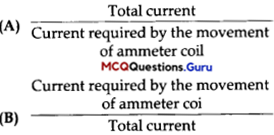
(C) Current required by the movement of ammeter coil X Total current
(D) None of the above
Answer:
Option (A) is correct
![]()
Question 2.
Materials used for making shunt of DC and AC ammeter are respectively
(A) Manganin and Manganin
(B) Manganin and Copper
(C) Manganin and Constantan
(D) Constantan and Manganin
Answer:
(C) Manganin and Constantan
Question 3.
Current through shunt is –
(A) greater than current through ammeter coil.
(B) less than current through ammeter coil.
(C) equal to the current through ammeter coil.
(D) may be greater than or equal to or less than current through ammeter coil.
Answer:
(A) greater than current through ammeter coil.
Question 4.
How shunt is connected with a ammeter?
(A) In series when connected externally
(B) In parallel when connected externally
(C) In parallel when connected internally
(D) Both (B) and (C)
Answer:
(D) Both (B) and (C)
![]()
Question 5.
What will be the value of the shunt resistance if the ammeter coil resistance is lf2 and multiplying power is 100?
(A) 1/99 Ω
(B) 99 Ω
(C) 101 Ω
(D) 1/101 Ω
Answer:
(A) 1/99 Ω
Explanation:
RSH = Rm / (m – 1) = 1/(100 – 1) = 1/99 Ω
II. Read the following text and answer the following questions on the basis of the same:
Types of resistors:
Most common type of resistor is Carbon Composition Resistors. Carbon resistors are a cheap, general purpose resistor used in electrical and electronic circuits. Their resistive element is manufactured from a mixture of finely ground carbon dust or graphite and a non-conducting ceramic powder to bind it all together. The ratio of carbon dust to ceramic (conductor to insulator) determines the resistive value of the resistor. Higher the ratio of carbon, lower the overall resistance.
Film Type Resistors consist of Metal Film, Carbon Film and Metal Oxide Film .Such resistors are generally made by depositing pure metals, such as nickel, or an oxide film, such as tin-oxide, on an insulating ceramic rod or substrate. The resistive value of the resistor is controlled by increasing the desired thickness of the deposited film giving them the names of either “thick-film* resistors” or “thin-film resistors”.Film type resistors can achieve much higher ohmic value compared to other types.
![]()
Another type of resistor, called a Wirewound Resistor, is made by winding a thin metal alloy wire (Nichrome) or similar wire on an insulating ceramic former in the form of a spiral helix. These types of resistors are generally only available in very low ohmic value with high precision . They are able to handle much higher electrical currents than other resistors of the same ohmic value with much excessive power ratings. These high power resistors are moulded into an aluminium heat sink body with fins attached to increase their overall surface area to promote heat loss and cooling.
Question 1.
Carbon composition resistors are made from a mixture of –
(A) finely ground metal dust and ceramic powder.
(B) finely ground carbon dust or graphite and ceramic powder.
(C) finely ground carbon dust or graphite and copper powder.
(D) finely ground carbon dust or graphite.
Answer:
(B) finely ground carbon dust or graphite and ceramic powder.
Explanation:
Carbon Composition Resistors are manufactured from a mixture of finely ground carbon dust or graphite and a non-conducting ceramic powder to bind it all together.
![]()
Question 2.
In carbon composition resistors, ………….. the ratio of carbon, ………….. the overall resistance.
(A) Higher, lower
(B) Lower, higher
(C) Lower, lower
(D) Higher, higher
Answer:
(A) Higher, lower
Explanation:
The ratio of carbon dust to ceramic (conductor to insulator) determines the resistive value of the resistor. Higher the ratio of carbon, lower the overall resistance.
Question 3.
Metal Film Type Resistors are generally made by depositing pure …………. on ………… rod or substrate.
(A) Ceramic, metal
(B) Carbon, ceramic
(C) Metal, ceramic
(D) Carbon, metal
Answer:
(C) Metal, ceramic
![]()
Explanation:
Metal Film Type Resistors are generally made by depositing pure metals, such as nickel on an insulating ceramic rod or substrate.
Question 4.
Wirewound Resistors are made by winding a thin ………….. or similar wire on an …………. former in the form of a spiral helix.
(A) Nichrome, copper
(B) Nichrome, ceramic
(C) Copper, ceramic
(D) Copper, Nichrome
Answer:
(B) Nichrome, ceramic
Explanation:
Wirewound Resistor, is made by winding a thin metal alloy wire (Nichrome) or similar wire on an insulating ceramic former in the form of a spiral helix.
![]()
Question 5.
Wire wound resistors are available in very …………… ohmic high precision values with ………….. power rating.
(A) High, high
(B) Low, low
(C) High, Low
(D) Low, high
Answer:
(D) Low, high